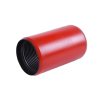api 5ct casing coupling
Understanding API 5CT Casing Couplings
API 5CT is a widely recognized standard issued by the American Petroleum Institute (API) that governs the specifications for casing and tubing in the oil and gas industry. The standard focuses on the design, materials, and testing requirements essential for the integrity and performance of casing systems under varying environmental conditions. At the heart of this standard is the casing coupling, an integral component which plays a crucial role in the seamless connectivity of casing pipes.
The Role of Casing Couplings
Casing couplings are critical for connecting two lengths of casing pipe, ensuring that the entire length of the wellbore is properly sealed and capable of withstanding substantial pressure. These couplings facilitate the transfer of loads from the casing to the surrounding geological formations, thus preventing collapse or deformation due to shifts in the earth or pressure changes. Depending on the well conditions, differences in temperature, and the nature of the fluids involved, the selection of the right casing coupling becomes vital for successful drilling operations.
Specifications and Standards
The API 5CT standard classifies casing couplings into various hardness types and grades, tailored to different well conditions. Each type is designed to meet specific mechanical properties, including yield strength, tensile strength, and impact resistance. For instance, coupling materials must be resistant to corrosion, especially in sour environments where Hydrogen Sulfide (H2S) is present. Materials typically used in the manufacturing of API 5CT couplings include carbon steel and alloy steel, ensuring they can withstand the harsh conditions they encounter underground.
Types of Casing Couplings
Casing couplings can be categorized into two primary types flush joint and non-flush joint. Flush joint couplings allow for full utilization of the casing's outer diameter, providing a continuous flow path, which is beneficial for wellbore stability. On the other hand, non-flush joint couplings, which protrude from the outer diameter of the casing, provide additional strength and can be advantageous in high-pressure applications.
api 5ct casing coupling

Additionally, couplings may also come with various thread types—for example, API round threads and buttress threads—that determine how they will engage with casing pipes. The choice of thread type influences the ease of make-up and break-out procedures during installation and maintenance.
Manufacturing and Quality Control
The manufacturing process of API 5CT casing couplings involves several key stages forging, machining, and quality control inspections. Forging helps create the necessary shape and structural integrity, while machining achieves the precision required for the threads and sealing surfaces. After these stages, rigorous quality control measures, including non-destructive testing (NDT), are implemented to ensure that the couplings meet the expected standards for strength and durability.
Importance of Proper Installation
Even the most robust casing couplings will fail if not installed correctly. Proper torque specifications must be followed during the installation process to prevent leakage or mechanical failure during drilling. Furthermore, regular inspections and maintenance of the couplings are suggested to ensure they perform optimally throughout the lifespan of the well.
Conclusion
In summary, API 5CT casing couplings are essential components in the oil and gas industry, ensuring the structural integrity of well casings under various conditions. Their proper selection, manufacturing, and installation are vital for the success of drilling operations. By adhering to the API 5CT standards, operators can ensure that their wells are not only efficient but also safe, thereby protecting the investment involved in exploration and production activities. Awareness and understanding of these standards can lead to improved operational reliability and reduced risks in energy extraction processes.
-
Choosing the Right Pup Joint Manufacturers for Oil and Gas OperationsNewsAug.22,2025
-
Tubing Coupling: The Small Connector with a Big ImpactNewsAug.22,2025
-
Tubing Crossover: The Essential Connector for Well IntegrityNewsAug.22,2025
-
Precision Flow Control in Well CompletionsNewsAug.22,2025
-
Casing Pup Joint for Optimal Well PerformanceNewsAug.22,2025
-
Reliable Connections with Wholesale Finished Casing CouplingNewsAug.22,2025







